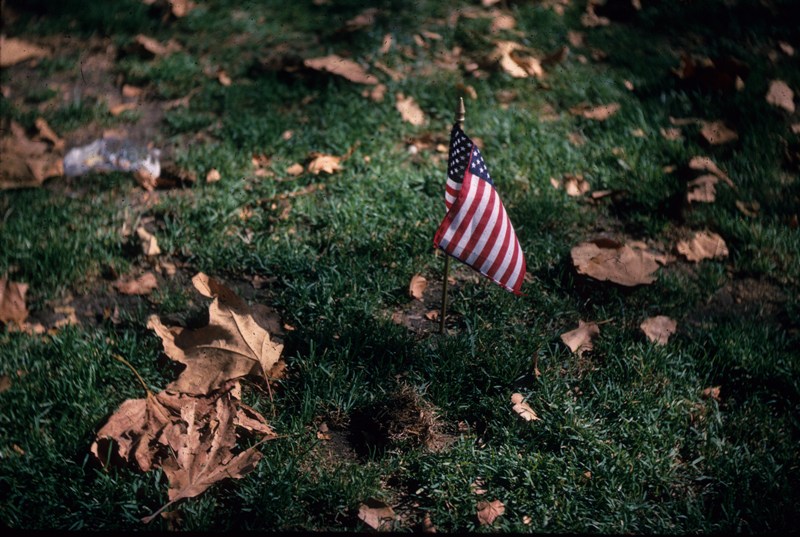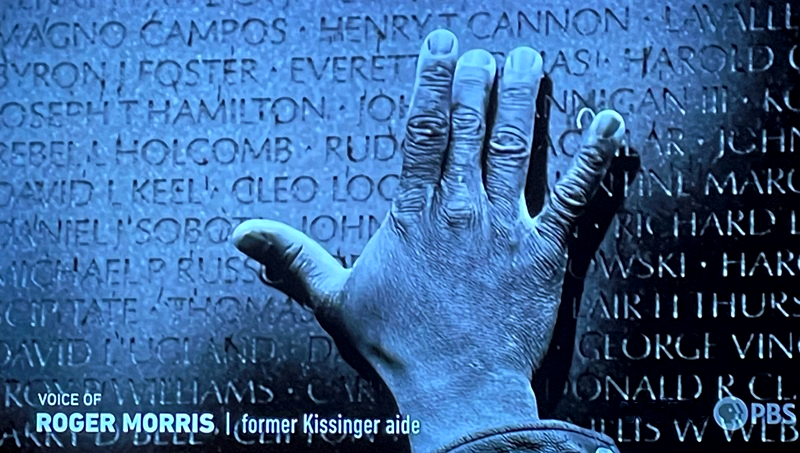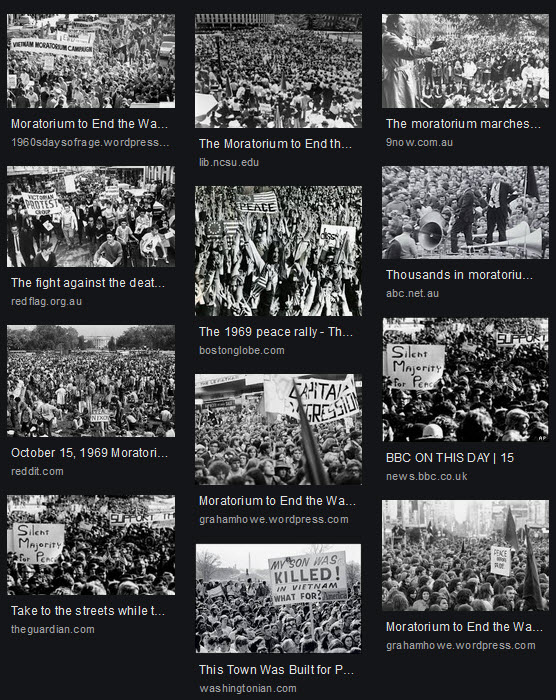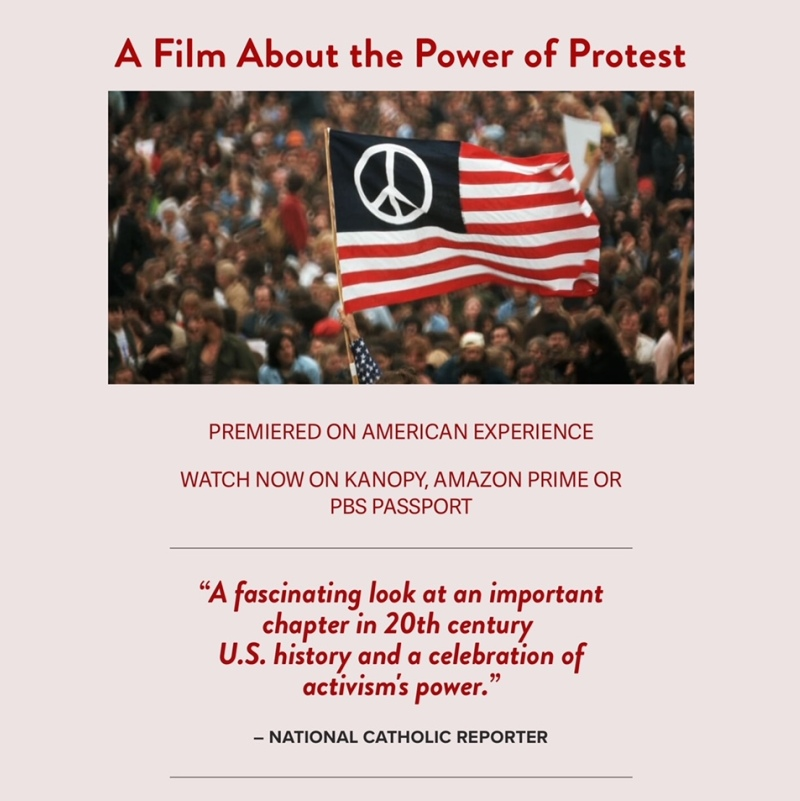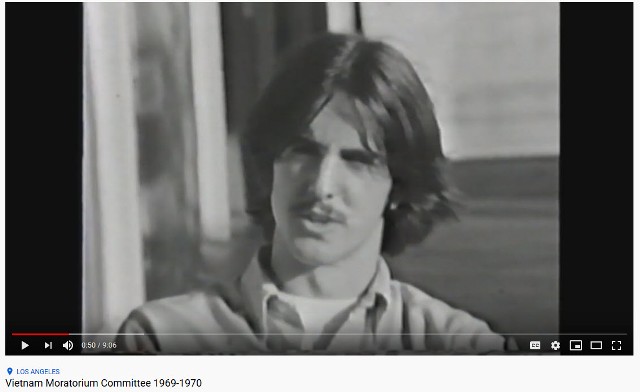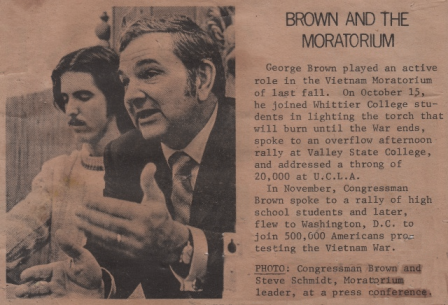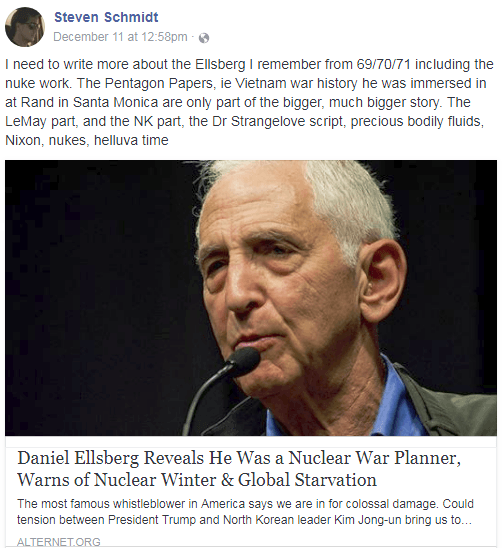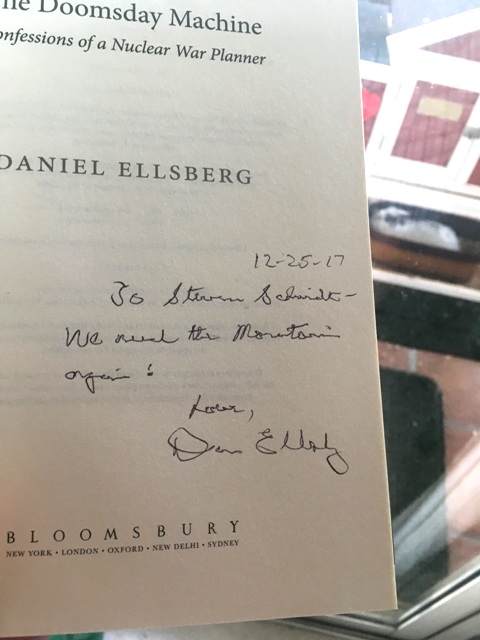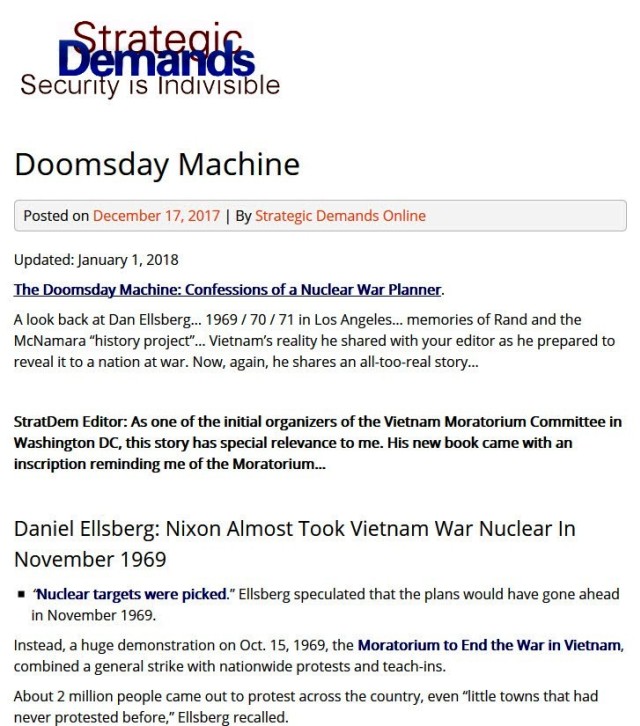Vietnam Moratorium for Peace 1969-1970
- https://www.greenpolicy360.net/w/File:Moratorium_memory,_Dan-Steve,_Doomsday_Machine_inscription.jpg
Attempting to Turn from War to Peace
A Counterculture and Environmental Movement in the Making
Memories of the Vietnam Moratorium and how Peace Action Led to the First Earth Day - 1969-70
Memories on the 50th Anniversary of the First Earth Day
The Vietnam Moratorium Inspires Organizing the First Earth Day
Earth Day Founder Senator Nelson Speaks with Organizers at USC
Calif. Congressman George E. Brown Pushes Forward with Students
A Modern Environmental Movement Rises Up, Becoming a Global Force
- Update: 2023
The Peace Movement Acted to Prevent the Use of Nuclear Weapons
The Movement and the Madman - PBS - March 2023
Re: National Security Council (NSC) advisors who objected to Nixon-Kissinger Vietnam secret action - Halperin, Lake, Morris
PBS
The Movement and the 'Madman'
PREMIERED MARCH 28, 2023 ON "AMERICAN EXPERIENCE"
The Vietnam Moratorium mobilization of October-November 1969 is revealed to have politically influenced and stopped US President Nixon from using nuclear weapons
The documentary film tells the story of a dramatic showdown between a protest movement and a president
································································································
A Call Out of the Blue and a War Remembrance
Steven Schmidt/GreenPolicy360 Founder/Siterunner:
Some fifty years after being an organizer of the Vietnam Moratorium in 1969, I received a call from a Vietnam war documentary production. They wanted remembrance comments of what it was like, up close, organizing a national peace movement. My response was "it was overwhelming" and... have you talked to Roger Morris? They said they intended to, they knew about Roger and did I have have his contact number. My next statement, which I repeated strongly over a period of months, filling in details, came from Dan Ellsberg, who was a friend and, in former times, a nuclear war planner. I spoke of Roger and the NSC, and nuclear weapons, and Dan's book, the Doomsday Machine, and suggested the documentary producers look into the Vietnam story of Nixon-Kissinger and "the Bomb".
Those who objected to secret plans back then by Nixon-Kissinger to expand the war beyond Vietnam, bombing Cambodia, Laos and planning, as it turned out, to 'send a message' to Hanoi via nuclear weapon use. These NSC staffers left government, with personal and professional consequences, and their experiences were not revealed until many years later. The Movement and the Madman PBS - American Experience film now tells the tale, and it is a shocking story. We should listen carefully, as the story of the Bomb and Vietnam comes to light, how nations of the world came close to experiencing nuclear disaster, a Cold War that would have instantly and forever become a Hot War with reverberations continuing until the present day.
Our peace organizing, it turned out, had profound impacts then and now as revealed by PBS's Movement and Madman.
Back in the day --
- Steven Schmidt, 1969
- University of Southern California
- Steve Schmidt, Moratorium Coordinator, and Rep. George Brown
The Vietnam Moratorium Committee - Organizing 'Peace Movement' Action
Vietnam Moratorium for Peace
Moratorium to End the War in Vietnam
1969-1970 | Millions across the U.S. Demonstrate, March, Organize, Teach-in and Rally for Peace
Watch a documentary film, directed by Robert Carroll, about the Vietnam Moratorium.
USC was the organizing hub for colleges and universities in California... On October 15, 1969, and in November, tens of thousands in Los Angeles, hundreds of thousands in California, and millions more across the U.S. rallied with historic demonstrations.
Read More @GreenPolicy360 about the Vietnam Moratorium peace movement
* https://www.greenpolicy360.net/w/File:Oct_15,_1969,_Vietnam_Moratorium_Day_in_memory.jpg
Steve Schmidt, GreenPolicy360 Founder and Strategic Demands Editor: The peace movement actions in October/November 1969 grew from our student-led start into the largest anti-war protests in the nation's history. As with the history of the Vietnam war, compiled by Daniel Ellsberg under order by Robert McNamara, and later to be revealed and called "The Pentagon Papers", the Moratorium actions were impactful in ways not realized immediately. Dan Ellsberg, a nuclear war planner, wrote in his 2017 book, "The Doomsday Machine" that use of nuclear weapons was prevented by these historic peace movement actions.
Although many know of Dan Ellsberg from his role in releasing the history of the Vietnam War, the story that became known as the "Pentagon Papers", his role as a U.S. nuclear war planner is much less known. I knew Dan and I've worked with Roger Morris, formerly of the National Security Council and an aide to Henry Kissinger. The story of how close we came to nuclear war needs to be told again, and remembered. It is a warning of how a president, any U.S. president, sane or not, can order 'first use' of nuclear weapons.
Stop and think, with a light now focused on a room in the White House in 1969. One of the singular figures is the US president, Richard Nixon, the other is the president's foreign policy adviser, Henry Kissinger. They are considering giving an executive order, a commander-in-chief is close to ordering the launch of nuclear war.
The president then, as is the case now, has "Singular Authority" to 'pull the trigger' and go nuclear.
Rational humanity came much too near the brink of nuclear cataclysm in those moments in 1969 as Nixon-Kissinger threatened the "4th rate power" of North Vietnam The world was spared though as outside the White House a people's movement rose -- and dissuaded the president and his aide. The Vietnam Moratorium turned out to be more powerful, much more powerful than was realized back then.
Today, as we review what has been revealed in subsequent years by insiders -- men with names like Morris, Lake, Halperin, Ellsberg -- we must realize it is time to exert further controls on out-of-control nuclear launch power. The 'singular authority' of the US president to launch nuclear Armageddon needs to be seen for what it is and re-thought. A new vision of nuclear sanity needs to be delivered by today's generation to protect future life. The potential for nuclear weapons accident, miscalculation, mistake, or purposeful intentional use has been a recurring threat, a threat that needs to be ended.
The Nixon nuclear episode reported here, of a president sending a "signal", a "savage, brutal blow" came too close to reality. God-like good fortune and anti-war Moratorium events, marches, and opposition by the American people prevented the nuclear fire resulting from a singular decision by an American president. Another time looking ahead, a politically powerful peace movement may not be organized in time.
How do we know a future president will not order nukes to be launched?
Read the series of pieces via Strategic Demands:
Read more at GreenPolicy360's associate, Strategic Demands
··································································································
How the Peace Movement and Vietnam Moratorium Inspired the First Earth Day 🌎
- Senator Gaylord Nelson Speaks of Student Peace Organizing as a Model for Organizing Environmental Teach-Ins
- Earth Day 2020
- 50th Anniversary of first Earth Day "Teach-In" / April 22, 1970
- Art by Olivia Schmidt / BY-NC
- Creative Commons / Use w/ Attribution + Non-commercial
On the 50th Anniversary
Memories on the Road to the First Earth DayA Personal Story, Your GreenPolicy360 Siterunner, Reflections of Olden Days - 1969/70/71
By Steven Schmidt / GreenPolicy360 Siterunner
Vietnam Moratorium Organizing 1969-70
• https://www.youtube.com/watch?v=9wLCWEU-6qA&t=32s
• https://www.greenpolicy360.net/w/File:Moratorium_October_15_1969.jpg
• https://www.greenpolicy360.net/w/File:Moratorium_memory,_Dan-Steve,_Doomsday_Machine_inscription.jpg
• https://www.strategicdemands.com/doomsday-machine/
SJS: The Moratorium organizing in 1969 was followed by talks between Representative George Brown and Senator Gaylord Nelson. A goal became building a similar nationwide student organized environmental day of action.
Senator Nelson, founder of Earth Day at USC
Congressman George E. Brown, East LA, with an environmental agenda
Looking back at the beginning of the modern environmental movement
SJS/GreenPolicy360 Siterunner: On the first Earth Day, April 22, 1970, a beginning of green ideals and ideas emerged in a serious way... Today Earth Day continues on as a movement and a political cause. Now we are a diverse mix, across the globe, employing the Internet with many voices, colors, ages, especially young people joining in. We continue on year after year, decade after decade.... We are strongly confronting and working to solve our generation's existential challenges. Reaching across our home planet, touching and interacting with planet citizens, looking to share solutions to pressing problems and challenges.
~
Environmentalism took on new forms and shapes with ideas that became a legal platform, a first generation of environmental laws that would go worldwide. A new "counterculture" with youthful vision and organizing added their voices and stood up to create the beginnings of a global environmental movement.
With a goal of protecting life, a new environmental movement began to grow, a "Whole Earth" vision seen for the first time from space in 1968 with the iconic Apollo 8 Earthrise image and a very real 'sense' of our common responsibility for the future of the planet. Students were 'first-movers' who spoke of the existential threat of nuclear war and environmental disaster, and need to 'become' far-reaching with a new vision. Realizations grew internationally that we had created weapons capable of ending humanity and most all life of earth -- and we needed to change this nuclear doomsday threat. Protests and 'teach ins', led by students, and drawing in politicians, communities, media, news with pamphlets, books, music, art and demonstrations crossed continents with new symbols, peace symbols, environmental and eco-awareness.
The threads of teach-ins led directly to and the first Earth Day in 1970 as students expanded counterculture with action.
Across the U.S., a first Earth Day of teach-ins began as a student-initiated movement on college campuses including your siterunner's college where we proposed an environment and peace action day to Senator Nelson, who we met as we organized the national Moratorium and who worked with us to make an Earth Day a national political event.
We invited Senator Nelson to speak at the University of Southern California for Earth Day and he agreed. Students who organized pro-peace and then pro-environment actions, as the Senator explained, inspired him to propose a national environmental action. The peace activists of the 1969 Vietnam war moratorium shared a positive vision of what was needed and he listened. In California meetings, he listened.Environmental protection, economic and social justice, new priorities added to the nation's agenda. The work spread quickly. A foundation of organizing sprang into action and Earth Day's teach-ins reached out to students and new networks formed globally. A worldwide environmental movement became a real and growing political force...
Senator Nelson, an eco-voyager who watched, met with, and listened to us:
"I am convinced that the same concern the youth of this nation took in changing this nation's priorities on the war in Vietnam and on civil rights can be shown for the problems of the environment. Successful teach-ins on all campuses on the same day will have a dramatic impact on the environmental conscience of the nation. They will be immensely effective as an educational effort in arousing public opinion..."
On an August day in 1969, Sen. Gaylord Nelson, a Democrat from Wisconsin, was in Santa Barbara inspecting what he later described as “that awful oil spill” and “puzzling about what could be done to bring public opinion to bear on the lethargic political community.” Over the next month he hatched a plan. Teach-ins — sit-ins that offered lessons about specific topics — were the rage in the activist 1960s, and Nelson wondered what might happen if the whole country engaged in a teach-in on how human activity imperiled the natural world. Thus Earth Day was born, and 50 years ago today some 20 million people — a tenth of the U.S. population — gathered at thousands of local events, propelling concerns about the environment onto the national agenda, where it’s been ever since.
* https://www.greenpolicy360.net/w/File:Earth_Day_50_years_on.jpg
····························································································
The Peace Movement Moves on to Environmental Protection Movement
A Counterculture and Environmental Movement in the Making
Nuclear Nonproliferation > Environmental Protection, Environmental Security
- https://greenpolicy360.net/w/Category:Nuclear_Nonproliferation
- https://www.greenpolicy360.net/w/Category:Environmental_Protection
- https://www.greenpolicy360.net/w/Category:Environmental_Security
- https://www.greenpolicy360.net/w/Category:Environmental_Security,_National_Security
Dan Ellsberg and US National Security Staff Remember the Moratorium's Effect on President Nixon
In his book recollecting his work as a nuclear war planner, Dan Ellsberg reveals how the Moratorium acted to prevent use of nuclear weapons
- Inscribed to Steven from Dan
Daniel Ellsberg: Nixon Almost Took Vietnam War Nuclear In November 1969
Revelations: the Vietnam Moratorium may have prevented use of nuclear weapons
“Nuclear targets were picked.”
- Ellsberg speculated that the plans would have gone ahead in November 1969.
- Instead, a huge demonstration on Oct. 15, 1969, the Moratorium to End the War in Vietnam, combined a general strike with nationwide protests and teach-ins.
- About 2 million people came out to protest across the country, even “little towns that had never protested before,” Ellsberg recalled.
“Without the Moratorium, there would have been an escalation, possibly the use of nuclear weapons in November 1969.”
The Movement and the Madman documentary film tells the little-known story of a dramatic showdown between a protest movement and a president ...
- The Vietnam Moratorium mobilization of October-November 1969 revealed to have stopped Nixon from using nuclear weapons.
Nixon and the Threat of Nuclear Weapon Use
- PBS Documentary 2023
○
About Dan Ellsberg, nuclear war planner, author of The Doomsday Machine
From the Publisher of Doomsday Machine:
Framed as a memoir ... A chronicle of madness in which Ellsberg acknowledges participating -- this gripping exposé reads like a thriller and offers feasible steps we can take to dismantle the existing "doomsday machine" and avoid nuclear catastrophe, returning Ellsberg to his role as whistle-blower. The Doomsday Machine is thus a real-life Dr. Strangelove story and an ultimately hopeful -- and powerfully important -- book about not just our country, but the future of the world.
Reviews
“A groundbreaking and nightmare-inducing account of how the whole mad system works.” – Esquire
“The Doomsday Machine is being published at an alarmingly relevant moment, as North Korea is seeking the capability to target the United States with nuclear missiles, and an unpredictable president, Donald Trump, has countered with threats of 'fire and fury.'” – New York Magazine
“One of the best books ever written on the subject--certainly the most honest and revealing account by an insider who plunged deep into the nuclear rabbit hole's mad logic and came out the other side.” – Fred Kaplan, Slate
“Daniel Ellsberg's The Doomsday Machine (Bloomsbury) unpacks the power of our atomic arsenal.” – Vanity Fair
“Ellsberg, the dauntless whistle-blower, has written a timely plea for a reassessment of a weapons program that he describes as 'institutionalized madness.'” – San Francisco Chronicle, Best Books of the Year 2017
“A passionate call for reducing the risk of total destruction . . . Ellsberg's effort to make vivid the genuine madness of the 'doomsday machine,' and the foolishness of betting our survival on mutually assured destruction, is both commendable and important.” – New York Times Book Review, Editor's Choice
“Brilliantly and readably tackles an issue even more crucial than decision-making in the U.S. intervention in Vietnam, which is policy on the handling of nuclear weapons.” – Excellent December Books, Huffington Post
“This candid and chilling memoir describes how Ellsberg came to recognize that the U.S. military's approach to preparing for nuclear war was terrifyingly casual. If war came, the United States was ready to obliterate not only the Soviet Union but also China--a plan that would have immediately produced 275 million fatalities and then led to another 50 million, owing to the effects of radiation.” – Foreign Affairs, "Best Books of the Year"
“Gripping and unnerving . . . A must-read of the highest order, Ellsberg's profoundly awakening chronicle is essential to our future.” – *Starred review, Booklist (“High Demand Backstory”)
“Ellsberg's brilliant and unnerving account makes a convincing case for disarmament and shows that the mere existence of nuclear weapons is a serious threat to humanity.” – *Starred review, Publishers Weekly
“Noted gadfly Ellsberg returns with a sobering look at our nuclear capabilities . . . When the author hurriedly copied the contents of his RAND Corporation safe to reveal, in time, what would become known as the Pentagon Papers, that was just the start of it. He had other documents, even more jarring . . . Especially timely given the recent saber-rattling not from Russia but North Korea and given the apparent proliferation of nuclear abilities among other small powers.” – Kirkus Reviews
“His point is simple: We and our political leaders must stop thinking of nuclear war as a manageable risk. We must stop thinking of the possibility of nuclear war as normal.” – St. Louis Post-Dispatch, "Our Favorite Books of 2017"
“The Doomsday Machine: Confessions of a Nuclear War Planner blends personal recollections and historical analysis with a set of considered proposals for reducing the threat of apocalyptic war. Many years in the making, it's a book that arrives at an opportune moment.” – San Francisco Chronicle
“Ellsberg's book, perhaps the most personal memoir yet from a Cold Warrior, fills an important void by providing firsthand testimony about the nuclear insanity that gripped a generation of policymakers . . . The Doomsday Machine is strongest as a portrait of the slow corruption of America's national security state by layer upon layer of secrecy. He relates how the Cold War, the nuclear build-up and trillions of dollars of defense spending were compromised by information purposely withheld from the policymakers and politicians who debated and shaped our path” – Washington Post
“History may remember Ellsberg as the whistleblower who leaked the Pentagon Papers and helped end the Vietnam War, but his alarmingly relevant new book should also assure his legacy as a prescient and authoritative anti-nuclear activist. The Doomsday Machine, which takes its title from Dr. Strangelove, reads like a thriller as Ellsberg figures out that America's pledge never to attack first was fiction and that the so called 'fail-safe' systems are prone to disaster.” – Los Angeles Review of Books
“Ellsberg writes briskly in the service of opinions formed by long and sober study. What he means is never in doubt and it is always interesting . . . He is a vigorous writer with a gift for dramatic tension and the unfolding of events as they cascade toward disaster.” – Thomas Powers, New York Review of Books
“Ellsberg presents his thoughts on how best to dismantle a program that could lead to global annihilation, while once again proving how deeply disturbing and radically ignorant our country's leaders are when it comes to thermonuclear warfare.” – SF Weekly
“The Doomsday Machine is chilling, compelling and certain to be controversial.” – Minneapolis Star Tribune
“Is it really necessary to declare that a knowledgeable, detailed and passionate book about the odds-on danger of cataclysmically destroying all human life on earth is important? Daniel Ellsberg's The Doomsday Machine demands to be widely read. Its claims should be examined by experts, corroborated, rebutted, taken up by Congressional committees (alas, unlikely) and generally forced into public consciousness . . . The Doomsday Machine is engrossing and frightening.” – Peter Steinfels, America Magazine (SJ)
“In the era of barbed insults regarded as precursors to nuclear threat, the warnings yielded by The Doomsday Machine have become required reading. . . . Daniel Ellsberg's title evokes Kubrick's film on purpose, a metaphor that culminates in his definition of the 'Strangelove Paradox.' The United States has thousands of 'Doomdsay Machine' weapons and hundreds of 'fingers on the button.' The question the reader must ask, now mortified by the necessary horrors of Ellsberg's masterpiece, is how to save the world” – Nuclear Age Peace Foundation
“The Doomsday Machine is, in fact, a Bildungsroman, a tale of one intellectual's disillusionment with the country in which Ellsberg had placed so much trust. It reveals how the horrors of US nuclear war planning transformed a man of the establishment into a left-wing firebrand.” – Los Angeles Times
“[The Doomsday Machine is] an important tome that's as optimistic as it sounds. It's vital reading that reminds people that both poor planning--such as the US under Dwight Eisenhower having no contingency in place for only bombing the USSR into dust, but it being a package deal with China, something that confirmed the rigidity of these planners as well as their blithely democidal tendencies--and the potential for simple mistakes still run rampant in US nuclear policy.” – Antiwar.com
“Gripping . . . The Doomsday Machine is essential reading--both a terrifying 'Doctor Strangelove' saga and a hopeful consideration of future scenarios.” – Mercury News
“Ellsberg's book is essential for facilitating a national discussion about a vital topic.” – *Starred review, Library Journal
“Alarming, galvanizing, and brilliantly written.” – Barnes & Noble Review
“Given the current crises, both domestic and international, the timeliness of Ellsberg's exposures-and warnings-is unnerving... The Doomsday Machine is not for the faint of heart, but its sense of urgency should make it required reading, and-more importantly-a call to action.” – BookPage
“From a close insider's perspective, he describes how the U.S. came to create and adjust this potentially world-destroying arsenal, how presidents have used it to threaten foreign leaders, and the responses of other nuclear powers. We have narrowly avoided many previous crises, but he fears that the current U.S. administration could charge straight into a worst-case scenario. This book deserves to be widely read, discussed and acted upon.” – Shelf Awareness
“In his recent book The Doomsday Machine, Daniel Ellsberg reports that the basic elements of US preparations for nuclear war have been little changed over the past three generations... Ellsberg's warning needs to be taken seriously.” – Truthout
“Speaking with the authority of an insider who was intimately involved with nuclear strategy and policymaking at the highest levels, he reveals that practically everything the American public believes about nuclear war and nuclear weapons is, quite simply, a 'deliberate deception.' . . . One can only hope Daniel Ellsberg's singular combination of moral credibility and personal knowledge will work its magic one more time to forestall an even greater tragedy than the Vietnam War.” – Undark Magazine
“The book is a revelation, and it raises so many essential questions that have been very inadequately discussed about nuclear war, realistic appraisal of its consequences and nuclear winter. Ellsberg places his discussion inside a history of the law of war since the early 20th century.... Ellsberg has performed his greatest public service yet with the publication of this book.” – The Concord Monitor
“A treasure of finely woven secrets and insights lies in Daniel Ellsberg's new memoir, The Doomsday Machine: Confessions of a Nuclear War Planner. Their importance grows each day that the nuclear stand-offs on the Korean Peninsula, in South Asia and between the United States and Russia go unabated.” – Carnegie Endowment for International Peace
“Shocking . . . The Doomsday Machine is full of deeply disturbing revelations. The book sometimes reads like a thriller, as Ellsberg describes his mounting horror and revulsion over the discoveries he made over the years.” – Berkleyside, 'Five out of Five'
“Daniel Ellsberg's latest book is a disturbing analysis about how close we have been--and still are--to a nuclear holocaust.” – Buffalo News
“As with the Pentagon Papers, Ellsberg has performed a public service in writing a candid book that states where we are more than seven decades into the nuclear era. This book provides abundant evidence that describes our nuclear predicament and how we got here, as well as ideas and insights that may help extricate us from the potentially devastating path we now walk.” – Arms Control Today
“This is a compelling and alarming book, and it should be read by anyone who cares about the human future.” – The Montreal Gazette
“There is much in Ellsberg's book that is new, and may even be revelatory to many readers . . . To be sure, Ellsberg is hardly the first Jeremiah to warn that nuclear war is 'a catastrophe waiting to happen' . . . Ellsberg is, nonetheless, the most recent, the best informed -- and plainly the most motivated -- to remind us, since then, of our present and continuing danger.” – H-Diplo
“An absolutely imperative read in this day and age of Trump, Putin, Kim Jong Un, and global instability.” – Helen Caldicott, Founding President, Physicians for Social Responsibility,
“This long-awaited chronicle from the father of American whistle-blowing is both an urgent warning and a call to arms to a public that has grown dangerously habituated to the idea that the means of our extinction will forever be on hair-trigger alert.” – Edward Snowden
“Nobody could have told this horrifying story better than Daniel Ellsberg. He introduces us to the men who have coldly and with a God-like sense of righteous entitlement, put in place a plan that can, on a whim--not virtually, but literally--annihilate life on Earth. What a book.” – Arundhati Roy, anti-nuclear activist and Pulitzer Prize-winner, The God of Small Things.
“A fascinating and terrifying account of nuclear war planning by a consultant from the RAND Corporation at the highest levels of government in the Kennedy administration. Ellsberg tells us of the close calls with nuclear war and of the policies developed then that still threaten the planet with annihilation. I couldn't put the book down.” – Frances FitzGerald, Pulitzer Prize-winning author of FIRE IN THE LAKE.
○
- Anthropocene
- Atmosphere
- Atmospheric Science
- Biodiversity
- Clean Air
- Clean Water
- Earth
- Earth Day
- Earth Science
- Earth360
- EarthPOV
- Eco-nomics
- Eco-Spirituality
- Ecology Studies
- Ecotourism
- Education
- Energy Policy
- Environmental Laws
- Environmental Protection
- Environmental Security
- Environmental Security, National Security
- EOS eco Operating System
- Forests
- Green Best Practices
- Green Energy Initiatives
- Green Party
- Green Politics
- Green Values
- Health
- Natural Resources
- Nuclear Nonproliferation
- Nuclear Proliferation
- Nuclear Weapons
- Oceans
- Ocean Science
- Peace
- Planet Citizen
- Planet Citizens
- Planet Citizens, Planet Scientists
- Renewable Energy
- Resilience
- Strategic Demands
- Sustainability
- Sustainability Policies
- US Environmental Protection Agency
- Water Quality
- Whole Earth
